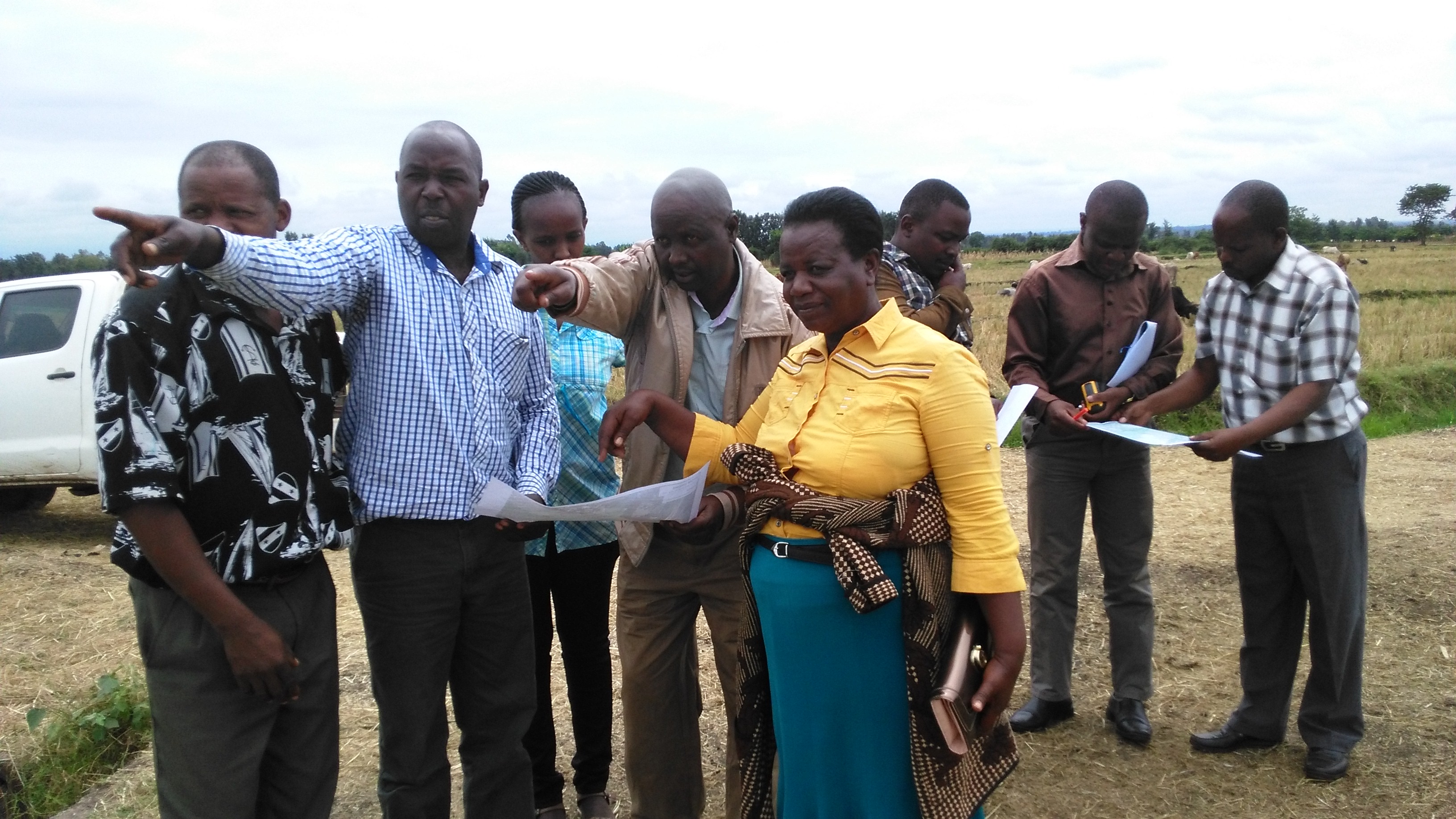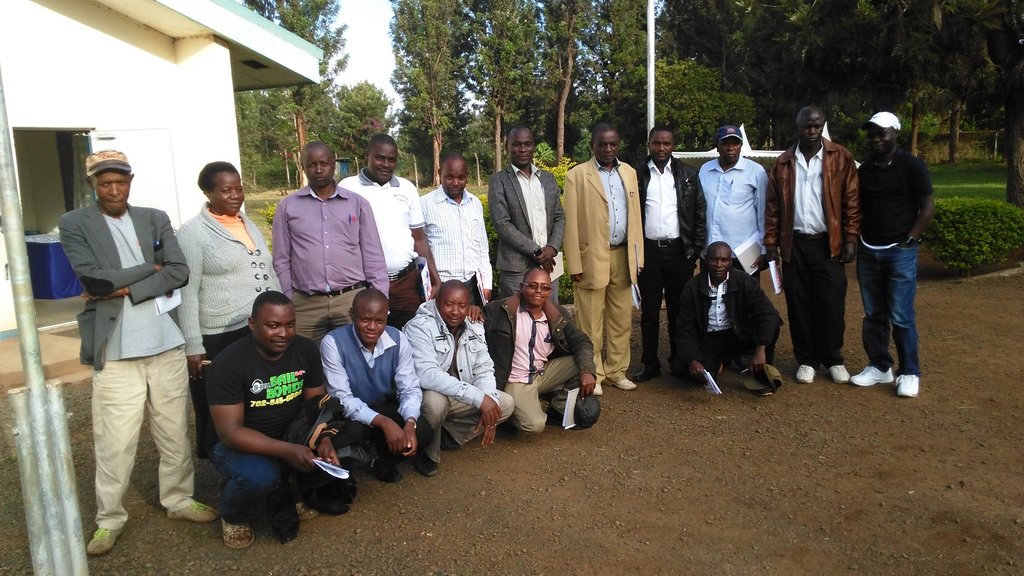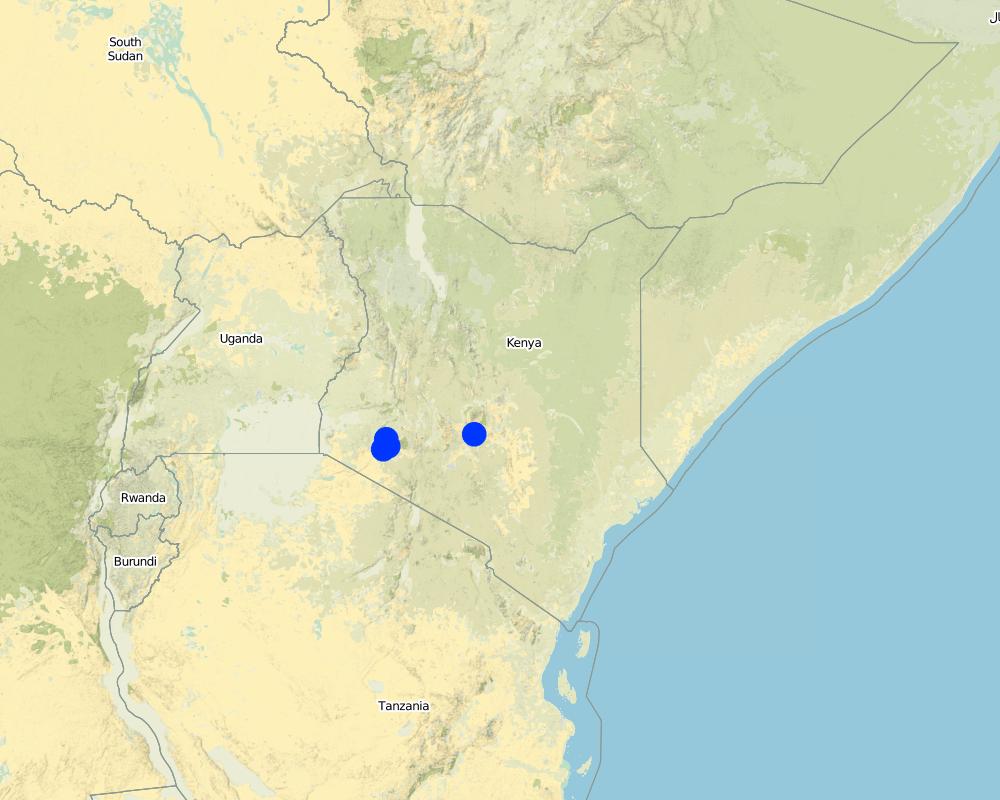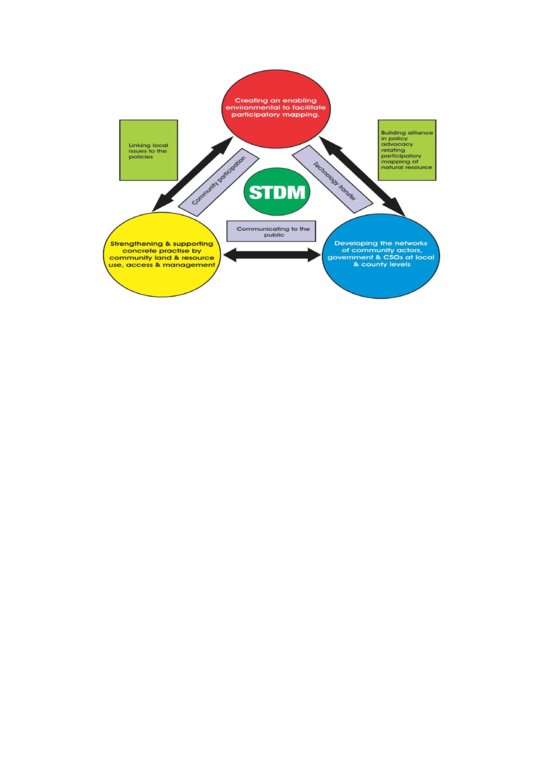Participatory Community Resource Mapping using Social Tenure Domain Model (STDM) [Kenya]
- Création :
- Mise à jour :
- Compilateur : Ken Otieno
- Rédacteur : –
- Examinateur : Rima Mekdaschi Studer
STDM Project
approaches_3379 - Kenya
- Résumé complet en PDF
- Résumé complet en PDF pour impression
- Résumé complet dans le navigateur
- Résumé complet (non formaté)
- Participatory Community Resource Mapping using Social Tenure Domain Model (STDM): 5 mars 2018 (inactive)
- Participatory Community Resource Mapping using Social Tenure Domain Model (STDM): 19 mai 2018 (inactive)
- Participatory Community Resource Mapping using Social Tenure Domain Model (STDM): 4 juin 2018 (inactive)
- Participatory Community Resource Mapping using Social Tenure Domain Model (STDM): 3 septembre 2018 (public)
Voir les sections
Développer tout Réduire tout1. Informations générales
1.2 Coordonnées des personnes-ressources et des institutions impliquées dans l'évaluation et la documentation de l'Approche
Personne(s) ressource(s) clé(s)
Spécialiste GDT:
Nom du ou des institutions qui ont facilité la documentation/ l'évaluation de l'Approche (si pertinent)
Resource Conflict Institute (RECONCILE) - Kenya1.3 Conditions relatives à l'utilisation par WOCAT des données documentées
Quand les données ont-elles été compilées (sur le terrain)?
04/09/2017
Le compilateur et la(les) personne(s) ressource(s) acceptent les conditions relatives à l'utilisation par WOCAT des données documentées:
Oui
2. Description de l'Approche de GDT
2.1 Courte description de l'Approche
Social Tenure Domain Model (STDM) is about people and their relationships with land. The tool as applied secures tenure through the recognition of tenure diversity and social contexts. STDM recognizes that secure tenure builds confidence among the resource users and therefore promotes investments confidence at different levels including; small scale, large scale both urban and rural investors who all need secure tenure.
2.2 Description détaillée de l'Approche
Description détaillée de l'Approche:
Background
The Rangelands Initiative Africa is a programme of the International Land Coalition (ILC) that is working to make rangelands more tenure secure. Resource Conflict Institute (RECONCILE) hosts and coordinates the Africa component while ILRI hosts and coordinates the Global component. Rangelands Initiatives existence recognizes that rangelands diverse resources and interests transcends across different stakeholders and therefore learning within these groups is important for strategic interventions and responses. As such, the programme supports ILC members and partners in upscaling their initiatives, documenting good practices and creating spaces for lessons sharing and learning.
RECONCILE seeks to demonstrate the application the Social Tenure Domain Model (STDM) in a rural setting has been able to secure social tenure rights for increased production among smallholder farmers. This land management and tenure security programme sought to address the dynamics around common resources in Bomet. Recognizing that there are multiple claims to common resources; the technology uses the people as the central nexus in land administration. As such, an extensive range of systems and processes to manage land through effective and accurate planning and management.
Context
Land as a factor of production attracts interests from stakeholders. As such, secure access to land, whether through formal, informal, customary or other means, is necessary for rural households to enjoy sustainable livelihoods, and is an important part of sustainable development. Securing access by rural poor people to land and water rights is key to the reduction of extreme poverty and hunger, since land and water are among the most important assets that poor rural women, youths and men have. Kenya has legal, policy and institutional frameworks and governance systems that presents options and opportunities.
The process of the technology
STDM process involves, problem identification, stakeholder analysis, training, community enumeration, data collection both socio-economic and spatial data and total data management. The process allows an understanding and testing the extent STDM technology responded to gaps and how best they could be applied to cater for needs of all stakeholders within the rural, agricultural, communal land settings. The application of the technology demands complete data sets that are consolidated through total census of both resources users and resources.
In piloting the STDM in the county, 44 rangelands common resources identified, mapped and documented included; water points, grazing areas and cattle dips. These resources have a direct bearing on sustainable rangelands use and management supporting livelihoods system. Using a census survey with pre-tested structured questionnaires, 498 rangelands users (smallholder farmers) interviewed using participatory enumeration in Sugumerga. There were many constraints but of significance; the changing land use patterns, which introduced fencing off communally, used resources like water points, access routes. The agro-pastoralists and other rangelands users specifically have challenges in accessing common grazing lands.
2.3 Photos de l'approche
2.5 Pays/ région/ lieux où l'Approche a été appliquée
Pays:
Kenya
Région/ Etat/ Province:
Bomet county
Autres spécifications du lieu :
Kembu sub-county
Commentaires:
The project implementation was done in three counties two of which the actual approach applied these are Bomet and Kirinya.
Map
×2.6 Dates de début et de fin de l'Approche
Indiquez l'année de démarrage:
2016
Si l'année précise est inconnue, indiquez approximativement quand l'Approche a démarré:
il y a moins de 10 ans (récemment)
Date (année) de fin de l'Approche (si l'Approche n'est plus appliquée):
2017
Commentaires:
Even though the project ended with the contract with the UNHABITAT, RECONCILE is still progressing with the approach in other areas
2.7 Type d'Approche
- fondé sur un projet/ programme
2.8 Principaux objectifs de l'Approche
- Improve production
- Reduce, prevent, restore land degradation
- Conserve ecosystem
- Protect a watershed/ downstream areas
2.9 Conditions favorisant ou entravant la mise en œuvre de la(des) Technologie(s) appliquée(s) sous l'Approche
normes et valeurs sociales/ culturelles/ religieuses
- favorise
The approach is participatory and the communities consent to the process taking leadership as such it is an enabler.
disponibilité/ accès aux ressources et services financiers
- favorise
Based on secure tenure rights by way of confidence building, the communities as individual investors increase their investment and as a result increased income
cadre institutionnel
- favorise
The approach is engaging and therefore flexible to inclusion of different institutions including government and private
collaboration/ coordination des acteurs
- favorise
Promotes partnership and collaboration
cadre juridique (régime foncier, droits d'utilisation des terres et de l'eau)
- favorise
Strengthens such frameworks as participatory resource securing process that reinforces accountability and services delivery. It recognizes the multiple tenure and resource rights.
cadre politique
- favorise
The STDM process is compatible with diverse policy frameworks that supports the use and management of communal resources.
gouvernance foncière (prise de décisions, mise en œuvre et application des décisions)
- entrave
In circumstances where land governance is not well defined, the process posses challenges and sometimes expectations and or lack of it undermines the process
3. Participation et rôles des parties prenantes impliquées dans l'Approche
3.1 Parties prenantes impliquées dans l'Approche et rôles
- exploitants locaux des terres / communautés locales
Small holder dairy farmers.
These farmers and community members were the key players in data collection, were the users of the approach and technology.
- Spécialistes de la GDT/ conseillers agricoles
GIS specialists, Lawyers, development experts.
Provided skills and expertise.
- ONG
Technical University of Kenya, Regional Centre for Mapping Resources for Development, Pamoja Trust.
All these institutions had a role in the project based on their previous engagement with UNHABITAT.
Si plusieurs parties prenantes sont impliquées, indiquez l'organisme chef de file ou l'institution responsable:
RECONCILE was the lead
3.2 Participation des exploitants locaux des terres/ communautés locales aux différentes phases de l'Approche
| Participation des exploitants locaux des terres/ communautés locales | Spécifiez qui était impliqué et décrivez les activités | |
|---|---|---|
| initiation/ motivation | interactive | The communities internalized the process and as such were very engaging and even self mobilized for the tasks. |
| planification | interactive | Same as above. |
| mise en œuvre | interactive | These were the key people in all the process of resource identification mapping and protection of both communal and private resources identified and mapped. |
| suivi/ évaluation | auto-mobilisation | They still follow and report on status. |
3.3 Diagramme/ organigramme (si disponible)
Description:
Using technology to enhance production among farmers need well thought through approaches -Recognize diverse dynamics -Manage expectations
Auteur:
Ken Otieno
3.4 Prises de décision pour la sélection de la Technologie/ des Technologies
Indiquez qui a décidé de la sélection de la Technologie/ des Technologies à mettre en œuvre:
- tous les acteurs concernés dans le cadre d'une approche participative
Spécifiez sur quelle base ont été prises les décisions:
- les résultats de recherches?
4. Soutien technique, renforcement des capacités et gestion des connaissances
4.1 Renforcement des capacités/ formation
Une formation a-t-elle été dispensée aux exploitants des terres/ autres parties prenantes?
Oui
Spécifiez qui a été formé:
- exploitants des terres
- personnels/ conseillers de terrain
Formats de la formation:
- sur le tas
- entre agriculteurs (d'exploitants à exploitants)
- réunions publiques
4.2 Service de conseils
Les exploitants des terres ont-ils accès à un service de conseils?
Oui
Spécifiez si le service de conseils est fourni:
- dans les champs des exploitants?
- dans des centres permanents
Décrivez/ commentez:
The users are beneficiaries of a government programme in the areas and were the basis against which the approach was used to close the gap.
4.3 Renforcement des institutions (développement organisationnel)
Des institutions ont elles été mises en place ou renforcées par le biais de l'Approche?
- oui, beaucoup
Spécifiez à quel(s) niveau(x), ces institutions ont été renforcées ou mises en place:
- local
Précisez le type de soutien:
- renforcement des capacités/ formation
- équipement
4.4 Suivi et évaluation
Le suivi et l'évaluation font ils partie de l'Approche? :
Oui
Si oui, ce document est-il destiné à être utilisé pour le suivi et l'évaluation?
Non
4.5 Recherche
La recherche a-t-elle fait partie intégrante de l’Approche?
Non
5. Financement et soutien matériel externe
5.1 Budget annuel de la composante GDT de l'Approche
Si le budget annuel précis n'est pas connu, indiquez une fourchette:
- 10 000-100 000
5.2 Soutiens financiers/ matériels fournis aux exploitants des terres
Les exploitants des terres ont-ils reçu un soutien financier/ matériel pour la mise en œuvre de la Technologie/ des Technologies?
Non
5.3 Subventions pour des intrants spécifiques (incluant la main d'œuvre)
- aucun
Si la main d'œuvre fournie par les exploitants des terres était un intrant substantiel, elle était:
- volontaire
5.4 Crédits
Des crédits ont-ils été alloués à travers l'Approche pour les activités de GDT?
Non
5.5 Autres incitations ou instruments
D'autres incitations ou instruments ont-ils été utilisés pour promouvoir la mise en œuvre des Technologies de GDT?
Non
6. Analyses d'impact et conclusions
6.1 Impacts de l'Approche
Est-ce que l'Approche a autonomisé les exploitants locaux des terres, amélioré la participation des parties prenantes?
- Non
- Oui, un peu
- Oui, modérément
- Oui, beaucoup
Communities and the programme benefited and revamped the resource management committees.
Est-ce que l'Approche a permis la prise de décisions fondées sur des données probantes?
- Non
- Oui, un peu
- Oui, modérément
- Oui, beaucoup
The County governments greatly recognizes and appreciates the technology and approach to the extent that they will use the information and date in planning and resources allocation.
Est-ce que l'Approche a aidé les exploitants des terres à mettre en œuvre et entretenir les Technologies de GDT?
- Non
- Oui, un peu
- Oui, modérément
- Oui, beaucoup
Yes, the fact that the programme used local land users as key experts in the actual work has established local resources.
Est-ce que l'Approche a amélioré la coordination et la mise en œuvre de la GDT selon un bon rapport coût-efficacité?
- Non
- Oui, un peu
- Oui, modérément
- Oui, beaucoup
The partnership between and among government institutions have increased.
Est-ce que l'Approche a mobilisé/ amélioré l'accès aux ressources financières pour la mise en œuvre de la GDT?
- Non
- Oui, un peu
- Oui, modérément
- Oui, beaucoup
The concept of the bigger programme was to support milk bulking and this has been achieved through improved resources use and management which in turn has enhanced milk produce; volume and quality.
Est-ce que l'Approche a amélioré les connaissances et les capacités des exploitants des terres pour mettre en œuvre la GDT?
- Non
- Oui, un peu
- Oui, modérément
- Oui, beaucoup
To the extent that the community resource users are directly involved in resource use and management, knowledge and skills are enhanced due to exposure and interactive sessions.
Est-ce que l'Approche a amélioré les connaissances et les capacités des autres parties prenantes?
- Non
- Oui, un peu
- Oui, modérément
- Oui, beaucoup
The application of skills by local people influenced the thinking.
Partnership and collaborations developed
Est-ce que l'Approche a atténué les conflits?
- Non
- Oui, un peu
- Oui, modérément
- Oui, beaucoup
It was not the main thing though.
Est-ce que l'Approche a autonomisé les groupes socialement et économiquement défavorisés?
- Non
- Oui, un peu
- Oui, modérément
- Oui, beaucoup
They were not targeted directly but benefited from the wider community scope.
Est-ce que l'Approche a amélioré l'égalité entre hommes et femmes et autonomisé les femmes et les filles?
- Non
- Oui, un peu
- Oui, modérément
- Oui, beaucoup
Both men and women were equally involved in the process.
Est-ce que l'Approche a encouragé les jeunes/ la prochaine génération d'exploitants des terres à s'engager dans la GDT?
- Non
- Oui, un peu
- Oui, modérément
- Oui, beaucoup
The use if GPS was and incentive.
Est-ce que l'Approche a amélioré les questions foncières et des droits d'utilisation qui entravent la mise en œuvre des Technologies?
- Non
- Oui, un peu
- Oui, modérément
- Oui, beaucoup
The approach does not explicitly engage in issues of tenure but, in its implementation awareness is created.
Est-ce que l'Approche a conduit à améliorer la sécurité alimentaire et/ou la nutrition?
- Non
- Oui, un peu
- Oui, modérément
- Oui, beaucoup
This can be acknowledged to some degree but needs a study on the project impact on nutrition.
Est-ce que l'Approche a amélioré l'accès aux marchés?
- Non
- Oui, un peu
- Oui, modérément
- Oui, beaucoup
Was not a direct concern but yes, it did based on more milk production.
Est-ce que l'Approche a conduit à améliorer l'accès à l'eau et l'assainissement?
- Non
- Oui, un peu
- Oui, modérément
- Oui, beaucoup
Yes clean water.
Est-ce que l'Approche a conduit à l'utilisation/ sources d'énergie plus durables?
- Non
- Oui, un peu
- Oui, modérément
- Oui, beaucoup
by enhanced use of bio gas yes.
Est-ce que l'Approche a amélioré la capacité des exploitants des terres à s'adapter aux changements/ extrêmes climatiques et a atténué les catastrophes liées au climat?
- Non
- Oui, un peu
- Oui, modérément
- Oui, beaucoup
Est-ce que l'Approche a conduit à des emplois, des opportunités de revenus?
- Non
- Oui, un peu
- Oui, modérément
- Oui, beaucoup
6.2 Principale motivation des exploitants des terres pour mettre en œuvre la GDT
- augmenter la production
6.3 Durabilité des activités de l'Approche
Les exploitants des terres peuvent-ils poursuivre ce qui a été mis en œuvre par le biais de l'Approche (sans soutien extérieur)?
- oui
Si oui, décrivez de quelle manière:
The approach application did not attract any material gains or incentives but, the process was community centered thus the adoption.
6.4 Points forts/ avantages de l'Approche
| Points forts/ avantages/ possibilités du point de vue de l'exploitant des terres |
|---|
|
The approach was targeting identified problem that was felt by the actors/ implementer and communities in a joint mission. The approach demonstrated the capability to map livelihood resources of the rangeland users including those resources associated with milk production such as milk coolers, water points, cattle dips, food stores, grazing areas, salt licks, crush, animal corridors, forest e.t.c |
|
Collectively, communities were able to know the status (management) of communal shared resources and responsible persons. Establishment of the Land tenure system of shared communal resources and issues arising. Status (management) of private resources within the rangelands. |
| Points forts/ avantages/ possibilités du point de vue du compilateur ou d'une autre personne ressource clé |
|---|
| The approach uses participatory approach hence building community ownership. |
|
The mix of the approach bridges the gap through skills transfer and capacity building and in facilitating dialogue on issues affecting the community (Maps, reports). Ensures the adaptability of the process though technical, is simplified users can relate with and find value in their use contributed immense success. |
|
STDM database accommodate inclusion of social economic and spatial data that can be maintained, accessed and update by the communities anytime. Provided visual representation of available resources and their distribution and people can relate to spatial information on the map. |
|
Ownership of technology by local people who are now leading on data collection, customizing the template, developing reports and innovating on its use. |
|
|
6.5 Faiblesses/ inconvénients de l'Approche et moyens de les surmonter
| Faiblesses/ inconvénients/ risques du point de vue de l’exploitant des terres | Comment peuvent-ils être surmontés? |
|---|---|
| The design of the tool was a more urban oriented and took time to be adopted for rural use especially where land is communal and customs are key. | Created more awareness. |
| Faiblesses/ inconvénients/ risques du point de vue du compilateur ou d'une autre personne ressource clé | Comment peuvent-ils être surmontés? |
|---|---|
|
Difficult to setup the server environment where no internet is available. Engaging other service providers may be difficult and takes time (Internet service provider need to authorize setting up additional server). Appropriate devices for capturing data may necessity additional budget. |
The internet component remain a challenge. Technology is evolving and needs systematic information channels even with the community members. The process requires proper funding in order not to have a break in between. |
7. Références et liens
7.1 Méthodes/ sources d'information
- visites de terrain, enquêtes sur le terrain
900
- interviews/entretiens avec les exploitants des terres
900
- interviews/ entretiens avec les spécialistes/ experts de GDT
2
- compilation à partir de rapports et d'autres documents existants
7.3 Liens vers les informations pertinentes disponibles en ligne
Titre/ description:
RECONCILE end of project report and other progress reports are available for sharing
Titre/ description:
Food security in Bomet county
URL:
awsc.uonbi.ac.ke/sites/default/files/chss/arts/.../Bomet-final.doc
Liens et modules
Développer tout Réduire toutLiens
Aucun lien
Modules
Aucun module trouvé






